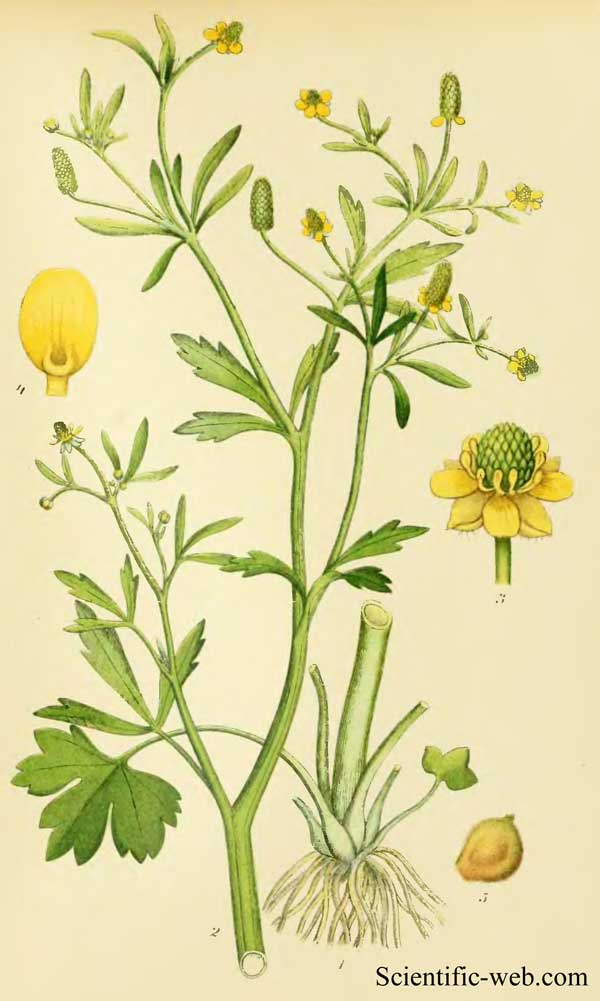
Ranunculus sceleratus
Classification System: APG IV
Superregnum: Eukaryota
Regnum: Plantae
Cladus: Angiosperms
Cladus: Eudicots
Ordo: Ranunculales
Familia: Ranunculaceae
Subfamilia: Ranunculoideae
Tribus: Ranunculeae
Genus: Ranunculus
Species: Ranunculus sceleratus
Name
Ranunculus sceleratus L.
References
Linnaeus, C. 1753. Species Plantarum. Tomus I: 551. Reference page.
USDA, ARS, Germplasm Resources Information Network. Ranunculus sceleratus in the Germplasm Resources Information Network (GRIN), U.S. Department of Agriculture Agricultural Research Service.
Vernacular names
العربية: حوذان شرير
čeština: Pryskyřník lítý
Cymraeg: Crafanc yr eryr
dansk: Tiggerranunkel
Deutsch: Gift-Hahnenfuß
English: Celery-leaf Buttercup
español: Apio sardónico
euskara: Irri-belar
فارسی: آلاله طاولدار
suomi: Konnanleinikki
français: Renoncule scélérate
Gaeilge: Toircheas fiáin
հայերեն: Գորտնուկ թունավոր
italiano: Ranuncolo di palude
日本語: タガラシ
қазақша: Улы сарғалдақ
한국어: 개구리자리
lietuvių: Nuodingasis vėdrynas
latviešu: Ļaunā gundega
norsk bokmål: Tiggersoleie
Nederlands: Blaartrekkende boterbloem
norsk nynorsk: Tiggarsoleie
norsk: Tiggersoleie
polski: Jaskier jadowity
русский: Лютик ядовитый
slovenčina: iskerník jedovatý
Seeltersk: Düüwelsbit
svenska: Tiggarranunkel
Türkçe: Zehirli düğün çiçeği
українська: Жовтець отруйний
Tiếng Việt: Mao lương
中文(简体): 石龍芮
中文(繁體): 石龙芮
Ranunculus sceleratus known by the common names celery-leaved buttercup,[1] celery-leaf buttercup,[2] and cursed buttercup[3] is a species of flowering plant in the buttercup family Ranunculaceae. It has a circumpolar distribution in the northern hemisphere, native to temperate and boreal North America and Eurasia, where it grows in wet and moist habitats, including ponds and streambanks.
Description
Ranunculus sceleratus is an annual herb growing up to half a meter tall. The leaves are more or less glabrous (hairless) and have small blades each deeply lobed or divided into three leaflets. They are borne on long petioles. The flowers are 5-10mm across with five or fewer yellow petals a few millimeters long and reflexed sepals. The fruit is an achene borne in a cluster of several.[4]: 110, 114
While buttercups are toxic due to the presence of the substance protoanemonin, this applies in particular for the cursed buttercup: it is the most toxic buttercup and contains 2.5% protoanemonin. When the leaves are wrinkled, damaged or crushed, they bring out unsightly sores and blisters on human skin.
Distribution
Ranunculus sceleratus has a circumpolar distribution in the northern hemisphere[5] There are two varieties and one subspecies[6] with distinctive distributions: R. sceleratus ssp. reptabundus occurs in northern Finland and north-west Russia.[5] R. scleratus var. multifidus occurs in north western North America.[5] and R. scleratus var. longissimus is found from Minnesota to Alabama according to their biodiversity and plant atlases respectively.
References
"Ranunculus sceleratus, Celery-leaved buttercup". London: Natural History Museum. Retrieved 27 May 2016.
Lee, Sangtae; Chang, Kae Sun, eds. (2015). English Names for Korean Native Plants (PDF). Pocheon: Korea National Arboretum. p. 602. ISBN 978-89-97450-98-5. Retrieved 15 March 2019 – via Korea Forest Service.
USDA, NRCS (n.d.). "Ranunculus sceleratus". The PLANTS Database (plants.usda.gov). Greensboro, North Carolina: National Plant Data Team. Retrieved 18 Oct 2015.
Stace, C. A. (2010). New Flora of the British Isles (Third ed.). Cambridge, U.K.: Cambridge University Press. ISBN 9780521707725.
Anderberg, Arne. "Ranunculus sceleratus (L.) Sw". Naturhistoriska riksmuseet, Stockholm. Retrieved 27 May 2016.
"The Plant List: Ranunculus sceleratus L". Royal Botanic Gardens, Kew and Missouri Botanic Garden. 2013. Retrieved 27 May 2016.
Retrieved from "http://en.wikipedia.org/"
All text is available under the terms of the GNU Free Documentation License

